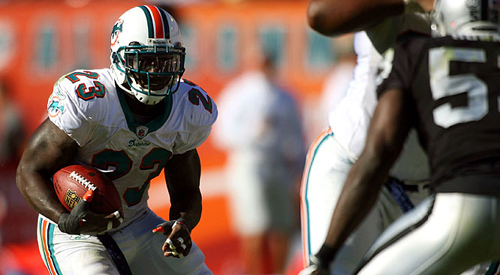
Where have all the Wildcats gone?
It’s no secret that the NFL is a copycat league. Any time one team tries something new and it works, whether it be the West Coast offense, the 3-4 defense or even the forward pass, other teams are bound to follow suit. One of the most interesting recent examples of this process of imitation is the Wildcat.
It also serves as a perfect example of why unconventional trends are often quickly rendered ineffective.
As popularized by the Miami Dolphins in 2008, the Wildcat involved lining up a running back (in the Dolphins’ case, usually either Ronnie Brown or Ricky Williams) to take a shotgun snap as a quarterback with the choice of handing off, running or throwing the ball.
As Brian Miller, who covers the Dolphins for Phin Phanatic explains, the Wildcat was a strategy the Dolphins adopted more out of necessity than anything else.
“A lot of the reason was personnel,” Miller said. “Chad Pennington was not a deep ball thrower. The team had started 0-2 and needed to break out. They didn’t expect it to work so well.”
Work well it did, though. According to a 2009 column by John Clayton of ESPN.com, the Dolphins wound up running 90 Wildcat plays during the 2008 season, resulting in 580 yards, eight touchdowns and, slightly more indirectly, 11 wins and the AFC East title.
[php snippet=1]
Naturally, many of the Dolphins’ NFL rivals rushed to adopt forms of the Wildcat for their own offenses. According to Clayton’s column, 16 of the other 31 franchises in the NFL besides Miami used some form of the Wildcat in 2008: Arizona, Atlanta, Baltimore, Buffalo, Chicago, Cincinnati, Cleveland, Dallas, Kansas City, New England, the New York Jets, Oakland, Philadelphia, San Diego, San Francisco and St. Louis.
Of course, anytime a strategy or gimmick is used that often, another team is bound to figure out an effective way to stop it sooner or later and when that happened to the Dolphins, it did so quite abruptly.
“They used it until someone figured out how to stop it,” Miller said of the Wildcat. “That was the Baltimore Ravens in the first round of the playoffs.”
Pennington threw four interceptions in that game, which saw the Dolphins lose 27-9 to the Ravens. Brown and Williams were held to a combined 16 yards rushing and Miami scored only one TD, only to see Baltimore block the extra point. Nevertheless, the Dolphins continued to try to make the Wildcat a permanent part of their offense. Miller believes that was a mistake.
“[It did] far more harm, in my opinion, than good,” Miller said. “First, it masked the base problems the team had with personnel in 2008 and the team actually spent a second-round draft pick on Pat White so he could run it. The team made offseason moves around the package as well and far too much time was spent building that than actually building a real base offense.”
The Wildcat hasn’t completely vanished from the NFL, but the teams that are still using it aren’t generally using it as frequently as the Dolphins once did. And only if they have the right players for it.
The Buffalo Bills have Brad Smith and the Cleveland Browns have Josh Cribbs, so unsurprisingly given that kind of talent, those teams still use some Wildcat plays. With Ronnie Brown’s injuries and Chad Henne replacing Pennington at QB in Miami, the Wildcat was no longer as practical for the Dolphins.
“The wildcat has declined because as teams become used to seeing it, it loses its effectiveness if you don’t have the right personnel,” said Matthew Warren, who covers the Bills for Buffalo Rumblings. “The Dolphins don’t have Ronnie Brown so they won’t use it as much. With Smith, the Bills have the personnel and will continue to use it.”
Warren said the Wildcat makes much more sense for up-and-coming teams than those that are already established along conventional lines.
“Teams that need an extra dimension will continue to use it,” Warren said. “Teams with great QBs will continue to pass since taking one of your best players off the field is pointless.”
In the end, that may sum up where the Wildcat is at now. It can still be an interesting gambit, but it’s no longer as unique of one, and may be best served as an option to go to when conventional attacks fail.
[php snippet=1]

